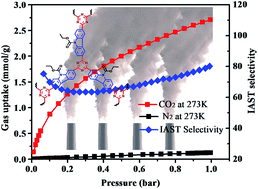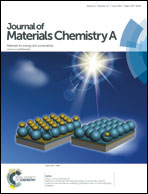Control of porosity of novel carbazole-modified polytriazine frameworks for highly selective separation of CO2–N2†
Abstract
Engineering porosity and surface functionalization in nanoporous organic polymers remain challenging. Here, we achieve control over the porosity as well as the pre-functionalization of pore walls of a carbazole-modified polytriazine framework by the introduction of three different appended functional groups (methyl, ethyl acetate and phenyl). All the synthesized nanoporous organic polytriazines (NOPs) display good thermal stability and high BET surface areas. The phenyl-anchored framework (NOP-21) exhibits the highest CO2 capacity (12.3 wt% at 273 K and 1 bar) and isoteric heat values (Qst, 37 kJ mol−1). Besides, the highest selectivity based on the ideal adsorbed solution theory (IAST) model at 273 K was amazingly observed for the ethyl acetate-appended framework (NOP-20): CO2–N2 81 (273 K, 1.0 bar), because of uniform ultramicropores through pore engineering. These results suggest a good feasibility for constructing high-performance organic porous CO2 sorbents by controlling porosity.


 Please wait while we load your content...
Please wait while we load your content...